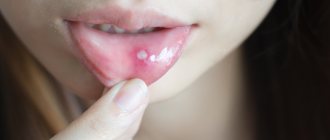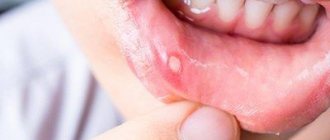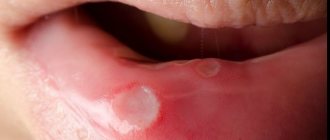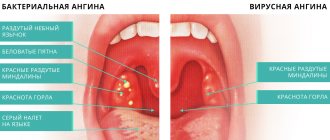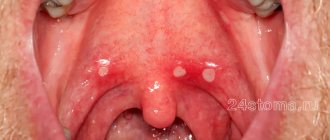What is stomatitis?
Stomatitis is an inflammation of the oral mucosa. According to statistics, about 20% of the population of our planet faces it. In adults and children, it can take the form of an independent disease or act as a symptom indicating pathologies of the body. In both cases, treatment is carried out comprehensively and under the supervision of a doctor.
What does the disease look like?
Stomatitis is not difficult to recognize. The initial stage of the disease is characterized by the appearance of mild swelling of the oral mucosa. It becomes redder, drier and shiny. A plaque may appear on its surface, and at the site of future lesions the patient feels an unpleasant itching or burning sensation.
As the disease develops, small ulcers and wounds appear on the mucous membrane - painful oval or round lesions. Their location may be the inside of the lips, cheeks, palate, tonsils, or mucous membrane under the tongue. Their appearance can be seen in the photo at the end of our article.
Causes of stomatitis
The mechanism of stomatitis is not yet fully understood. But scientists are inclined to believe that the root cause of its development is the reaction of the human immune system to various irritants. At some point, the immune system ceases to recognize the potential threat of internal and external factors, which causes its atypical reaction, as a result of which “aggressive behavior” of lymphocytes is observed. The attack of lymphocytes against irritant molecules leads to lesions of the oral mucosa.
A variety of factors can provoke an atypical reaction of the immune system. The most likely of them are the following irritants:
- Pathogenic microorganisms that live in the mouth.
- Improper oral hygiene.
- Various damage to the mucous membrane, for example, burns from eating too hot food or mechanical injuries from seeds, nuts, crackers and other hard foods.
- General dehydration due to high fever, blood loss, vomiting, diarrhea, or thirst.
- Poor quality treatment of teeth and gums.
- An allergic reaction to dental structures in the mouth - braces, implants, crowns, bridges, etc.
- Long-term use of medications.
- A diet depleted of beneficial vitamins and elements.
- Smoking.
- Malignant formations of the oral cavity, respiratory organs or undergoing a course of chemotherapy.
- Hormonal imbalances in the body, for example in pregnant women or children during puberty.
- The presence of chronic diseases or allergies.
- Severe stress.
Interesting to know! Frequent stomatitis in adults can be caused by the use of toothpaste containing sodium lauryl sulfate, a substance added to oral care products to form a thick foam. According to recent studies, it dehydrates the oral mucosa and makes it vulnerable to various types of irritants. Patient observation data confirms the fact that avoiding the use of sodium lauryl sulfate paste can reduce the risk of developing stomatitis in adults by 81%.
Symptoms of the disease
Stomatitis can occur at any age. In the early stages, its course is accompanied by swelling, redness and dryness of the oral mucosa. The main sign of the disease is the presence of one or multiple ulcers and their appearance.
- Oval or round ulcer shape.
- Small sizes.
- Smooth edges.
- The presence of a thin grayish or white film in the central part of the ulcer.
- The ulcer is surrounded by a slightly reddish halo.
- The mucosal tissue around the lesion has a normal, healthy appearance.
The slight itching or burning sensation that the patient experienced at the beginning of the disease is replaced by pain. The ulcers hurt when eating, talking and smiling broadly. Any touch to them causes pain, which complicates hygiene measures and leads to bad breath.
On average, the disease lasts from 4 to 14 days. Its clinical picture depends on the individual characteristics of the organism, the form and type of the disease. During this period, in addition to the main signs of pathology, other symptoms of the disease may be observed.
- Increase in temperature - during the first days, until characteristic ulcers appear (in severe forms of stomatitis, the elevated temperature persists throughout the entire illness).
- General malaise and fatigue.
- Chills.
- Headache.
- Lack of appetite (especially in children).
- Enlarged lymph nodes (in rare cases).
Important to remember! Severe inflammation, toothache or high temperature for a long time indicate a severe form of stomatitis or the development of its complications. In this case, immediate medical attention is required, and if necessary, hospitalization of the patient is possible.
Gels and ointments
The use of a variety of creams, gels, and ointments helps reduce pain, prevent the development of complications, relieve inflammation, and speed up the patient’s recovery. They form a protective film on the surface of the mucosa that promotes wound healing.
The effectiveness of ointments such as cholisal, vinylin, kalgel, lidochlor, levomekol has been proven. For the fungal form of the disease, miconase and methyluracil are used. To heal aphthae, sanviritrin and solcoseryl are used.
Below we will tell you about other popular ointments and gels.
Oxolinic ointment
For herpes stomatitis, especially in children, oxolinic ointment is used. It prevents the spread of the disease. The ointment is applied to the inflamed areas of the mucous membrane 3-4 times a day. It is advisable to first rinse your mouth with herbal decoctions or antiseptic solutions.
Metrogil Denta
The modern antiseptic Metrogyl Denta is prescribed for the treatment of aft. The gel is applied with a finger or a cotton swab directly to the surface of the aphthae twice a day. Not used in the treatment of children under six years of age.
Acyclovir (ointment)
The antiviral drug Acyclovir is effective in treating herpes infections. Anti-stomatitis ointment Acyclovir is prescribed for the herpetic form of the disease. Apply to the affected mucous membrane five times a day for a week.
Nystatin ointment
Intended for external use, it is used extremely rarely for the treatment of stomatitis. Nystatin ointment can be prescribed for oral candidiasis if alternative medications are ineffective. Apply a small amount to avoid overdose.
Kamistad gel
An excellent anti-inflammatory and analgesic, Kamistad gel is used in the treatment of all forms of stomatitis. Apply to the affected surface several times a day until complete recovery.
Can stomatitis go away on its own?
As a rule, mild forms of the disease caused by trauma to the mucous membrane, poor oral hygiene or an allergic reaction of the body can go away on their own. Severe stomatitis caused by infection requires qualified treatment. In both cases, it is better not to wait and not to self-medicate. Because the disease not only causes pain and discomfort, but can also lead to generalization of infection and serious complications.
Consequences and complications of the disease
Possible complications arise when the patient ignores treatment for stomatitis. As a result, mild and severe forms of the disease become chronic. The neglected process turns into an ulcerative-necrotic and then gangrenous form of the disease, as a result of which not only the mucous membrane is damaged, but also the soft tissues of the mouth and jaw bones.
Other serious consequences of untreated stomatitis include the following complications.
- Bleeding gums.
- Scarring of the oral mucosa, disruption of its elasticity and mobility.
- Attachment of a secondary infection.
- Tooth loss.
- Voice changes – hoarseness, hoarseness.
Important to remember! A small ulcer on the oral mucosa is a potential threat to the entire body. Infection from it can spread to other organs and systems, which will disrupt the functions of the heart, liver, kidneys, gastrointestinal tract and respiratory organs.
Tablets and antifungal drugs
When treating advanced forms of the disease, one cannot do without the use of tablets and antifungal drugs. They have a systemic effect on the human body, reduce inflammation, and promote a speedy recovery.
Among the most popular antibiotics are amoxilav, sumamed, flexmoxin solutab. Additionally, the doctor may prescribe anti-inflammatory drugs - imudon, methyluracil, biseptol.
Nystatin
Used in the treatment of candidal stomatitis. Its effectiveness is questionable. The course of treatment with nystatin is quite long. There are alternative modern drugs that help the patient recover faster.
Fluconazole
A strong antimycotic drug that is effective in the treatment of candidiasis. Fluconazole is prescribed 100 mg per day for 7-14 days for all forms of the disease. For recurrent stomatitis, pulse therapy is used - 150 mg once a week.
Lysobacter
Lizobact lozenges are used for stomatitis, sore throat, and tonsillitis. They have local antimicrobial and antiseptic effects. Prescribed for adults and children over three years of age. Take according to instructions.
Streptocide
Quite rarely used in the treatment of stomatitis due to its dubious effectiveness. Pour streptocide, ground into powder, onto a cotton swab, apply to the sore, and hold for 30 minutes. It is advisable not to swallow.
Candide
The antifungal drug Candide prevents the proliferation of fungi. It is prescribed for the treatment of candidal stomatitis. The solution is applied to the affected surface 3-4 times a day until complete recovery.
Folk remedies
For treatment, you can use traditional medicine. The following juices, decoctions, oils and infusions have proven themselves well.
You can gently lubricate the affected areas of the mucous membrane with juices and oils. Solutions and decoctions of herbs are used for regular rinsing of the mouth.
Important! Before using traditional medicine, you should consult a doctor. Only a specialist can determine the advisability of their use without harm to health. The use of folk remedies does not cancel the main therapy, but only complements its effect.
How many days does treatment last?
Correct, competent treatment of stomatitis significantly speeds up the healing process. Depending on the type of disease, it lasts for 3 to 7 days. If after 1 week of treatment the signs of the disease have not disappeared or worsening is observed, then the patient most likely has complications. The following factors may be the probable reasons for its development.
- The patient self-medicated or did not follow the doctor's instructions.
- Decreased immunity.
- The presence of chronic diseases of the body.
- Regular injury or infection of the oral mucosa.
- Undiagnosed allergy.
- Having bad habits - smoking, tearing, etc.
- Depression or frequent stress.
- Improper oral hygiene.
- Uncontrolled use of medications.
- The use of oral hygiene products containing sodium lauryl sulfate.
Returning to the question - can stomatitis go away on its own - it should be noted that a seemingly harmless disease can turn into serious problems for the patient. Therefore, you should remember three “don’ts” - don’t
engage in self-medication,
do not
put off visiting a specialist and
do not
ignore the recommendations of your doctor.
How to understand that stomatitis has passed?
Very simple! A complete cure is indicated by the absence of lesions in the oral mucosa. There are no small ulcers, wounds or plaque on the cheek, palate, lip, tongue or tonsil area. The mucous membrane looks healthy, is well moisturized, does not cause pain and does not create discomfort during eating, talking, smiling and performing hygiene procedures.
Free consultation on the cost of treatment in our dentistry
Leave a request and the clinic administrator will contact you within 15 minutes!
The cause of herpetic stomatitis can be not only a malfunction of the body’s general immunity, but also a deterioration of local immunity, in which the oral mucosa becomes sensitive to the effects of pathogenic microflora. Local immunity is reduced under the following circumstances:
- With poor oral hygiene, due to which hard and soft plaque begins to accumulate on dental surfaces and soft tissues;
- For untreated dental diseases;
- For tonsil infection;
- When you inhale air not through your nose, but through your mouth. It leads to dehydration of the mucous membrane, which is harmful because bacteria will penetrate the tissue more easily and quickly. Treatment methods
Since this form of stomatitis is caused by the herpes virus, the basis of treatment for the disease should be special antiviral drugs. However, these remedies show the greatest effectiveness in the initial stages of the development of the disease, until the blisters turn into ulcers. In the later phases of development, treatment with antiviral drugs will be ineffective.
Types of stomatitis in adults
The clinical picture of the disease indicates that stomatitis can be mild or severe, have an acute or chronic course. To facilitate the diagnosis and treatment process, experts have developed the following classification of the disease.
- Allergy is usually a chronic disease that occurs as a result of an allergic reaction of the body to an irritant. In addition to the characteristic ulcers, it may be accompanied by the appearance of white spots, blisters and small hemorrhages on the mucous membrane.
- Herpetic or herpes - the disease occurs due to the entry of the causative agent of the herpes virus into the human body. Stomatitis of this type is characterized by an acute course. Bubbles appear on the surface of the mucous membrane, which open to form erosions and crusts.
- Traumatic (bacterial) – a consequence of mechanical trauma to the oral mucosa and infection entering the wound. As a rule, the disease is mild, with symptoms characteristic of stomatitis.
- Catarrhal and catarrhal-hemorrhagic stomatitis is a mild form of stomatitis, the causes of which are poor oral hygiene, the development of candidiasis, decreased immunity or gastrointestinal pathologies. The disease is accompanied by a typical clinical picture for the disease.
- Candidal (fungal) stomatitis is an acute form of the disease, the so-called thrush, caused by the activity of bacteria of the genus Candida. It is most common in young children, the elderly, and patients who overuse antibiotics. Accompanied by the appearance of a white coating on the mucous membrane, a burning sensation and an unpleasant taste in the mouth.
- Ulcerative is a severe form of the disease that occurs independently or as a result of a complication of the catarrhal course of stomatitis. It occurs acutely, with increased body temperature and enlarged lymph nodes. The resulting ulcers are very painful and can unite and form extensive lesions of the mucous membrane.
- Aphthous stomatitis is a severe form of the disease, occurring acutely or chronically. Accompanied by the appearance of single or multiple gray-white ulcers. The ulcers are surrounded by a red halo and are very painful.
It is important to know! By analyzing the condition of the oral mucosa, the nature of the ulcers and the patient’s complaints, specialists accurately determine the type of stomatitis and make an accurate diagnosis. Thanks to this, treatment of the disease occurs quickly and without complications.
Antiseptic preparations and solutions
Successful treatment involves the use of antiseptic solutions, ointments, and other drugs. They prevent the proliferation of pathogenic bacteria on the inflamed mucosal surface, relieve inflammation, and promote rapid healing of ulcers.
For the viral form of the disease, medications are prescribed that, in addition to antibacterial properties, increase immunity and have an antiviral immunomodulatory effect.
Popular immunomodulators:
- Viferon;
- interferon;
- Lafarobion.
Effective for candidiasis:
- clotrimazole;
- vitaon;
- trypsin.
To disinfect the oral cavity, use:
- aekol;
- chlorophyllipt;
- iodinol;
- hexoral.
Below we will tell you how to treat stomatitis at home, what medications are prescribed to disinfect the oral cavity and relieve inflammation.
Iodinol (blue iodine)
Iodinol (blue iodine) has been successfully used to treat oral diseases. It is considered a safe antiseptic, suitable for adults and children. Used for rinsing, smearing, and applications. You should rinse your mouth with iodine for a week.
For children, it is preferable to lubricate the affected surface with a cotton swab dipped in the medicine.
Zelenka
The classic method of treating stomatitis is drying and disinfecting ulcers using ordinary brilliant green. It should be applied to the inflamed areas with a cotton swab 2-3 times a day.
Using brilliant green too often causes the mucous membrane to dry out!
To get rid of green marks, you need to brush your teeth thoroughly.
Methylene blue (blue)
In dentistry, an aqueous solution of blue is used to treat candidal stomatitis; an alcohol solution causes a burn to the mucous membrane. A cotton swab dipped in blue is used to lubricate all the sores in the patient’s mouth. The procedure should be carried out after each meal, after rinsing the mouth with a herbal decoction.
Lugol's solution
Lugol's solution has antimicrobial properties - an effective drug widely used for tonsillitis, sore throat, and inflammation of the tonsils. It is successfully used in dentistry. The inflamed mucous membrane is treated with a cotton swab soaked in Lugol's solution. Carry out the procedure until complete recovery.
Fukortsin
Fucorcin is an effective antimicrobial and antifungal drug. It promotes rapid healing of aphthae, destruction of pathogenic microbes and fungal spores.
Fukortsin is intended for external use; the oral cavity should be treated with extreme caution!
The medicine is carefully applied to the cleaned surface with a cotton swab. Do not lubricate healthy areas of the skin with the solution.
Hexoral
For candidiasis and herpetic stomatitis, hexoral, an antiseptic antimicrobial drug, is available in the form of liquid and spray. Twice a day you need to treat the inflamed surface with hexoral, do not swallow the medicine! The course of treatment is 5-7 days.
Which doctor should I contact for stomatitis?
If you notice the first signs of damage to the oral mucosa, you should immediately consult a dentist. After differential diagnosis of the disease and an accurate diagnosis, it is possible to observe it with a general practitioner or other specialized specialist, for example, an allergist.
Do not ignore preventive visits to the dentist.
It is enough to visit a specialist 1 – 2 times a year, which will allow you to promptly identify any dental problem at an early stage of development. This means that its elimination will be quick, easy and without complications.
By clicking the “request a call” button you agree to the personal data processing policy.
Sprays and aerosols
Inhalation with sprays for stomatitis is rarely used. They are indicated if instant results are needed. The medicine is immediately absorbed into the mucous membrane, so relief comes quickly.
Medicines in the form of a spray or aerosol should absolutely not be used in the treatment of children under 6 years of age, as they may inhale the drug.
Below we will introduce you to some fast-acting medications.
Bioparox
The inhalation drug Bioparox is used both for the treatment of diseases of the ENT organs and in dentistry. Has anti-inflammatory and bacteriostatic effects. It contains the polypeptide antibiotic fusafungin. Apply to the surface of the oral cavity 2 times a day.
Tantum Verde spray
The anti-inflammatory pain reliever Tantum Verde is available in the form of a spray and rinse solution. The only spray that is approved for use by infants. Used in the treatment of respiratory diseases. In dentistry it is prescribed to quickly relieve the symptoms of stomatitis.
Ingalipt
The combined drug has a disinfecting and anti-inflammatory effect. Effective in various forms of the disease. Ingalipt is applied to the affected areas of the mucous membrane 3-4 times a day. The course of treatment is 5-7 days. Before use, it is recommended to rinse your mouth with boiled water.
Ambassador
Effective in the treatment of ulcerative, aphthous, catarrhal stomatitis. Proposol contains propolis, glycerin and ethyl alcohol, so it has antimicrobial and anti-inflammatory effects. Spray in the mouth 2-3 times a day for a week.
We have told you different ways to cure stomatitis at home. It is advisable to consult a doctor about prescribing certain medications.
You should not take a large number of different medications at the same time. It is enough to choose one or two of the most effective products plus a variety of rinses.
How to distinguish stomatitis from other diseases?
The main sign of stomatitis is the presence of characteristic ulcers, the tissue around which looks healthy. The disease is rarely accompanied by systemic symptoms and, as a rule, recurs from time to time. For a competent specialist, it is not difficult to distinguish stomatitis from other ailments.
For a sore throat
When you have a sore throat, your body temperature always rises. In this case, it is not the ulcers themselves that hurt, but the throat area. Upon visual examination, the tonsils appear swollen, inflamed and red.
For herpes
The problem is that herpetic stomatitis is one of the manifestations of herpes. A viral disease is accompanied by the formation of characteristic blisters that burst and dry out. In the presence of other types of stomatitis, the nature of the ulcers is completely different.
For cancer
Ulcers due to cancer of the oral mucosa do not go away on their own even after treatment. Over time, they increase in size and may bleed and become painful.
From thrush
Candidal stomatitis is thrush caused by the activity of bacteria of the genus Candida. In all other cases, the nature of the disease will be different and can be easily distinguished from thrush by the presence of characteristic ulcers.
For syphilis
When infected with syphilis, a red spot appears on the surface of the mucous membrane. Gradually it thickens, takes the form of a dense nodule and ulcerates - a typical hard chancre is formed, which is completely different from ulcers with stomatitis.
Recommendations during treatment
Treatment of stomatitis should be carried out comprehensively - local therapy, taking medications appropriate to the type of disease, and strengthening the immune system. During the treatment period, you must adhere to the following recommendations.
- Compliance with the diet - you need to exclude from the diet spicy, salty, sour, too sweet, smoked, hot, cold and any dishes that are traumatic to the mucous membranes.
- Maintaining oral hygiene . To maintain it, it is necessary to use antiseptic agents that you regularly rinse your mouth with.
- Taking vitamin-mineral complexes that strengthen the body's protective functions.
If the doctor has diagnosed the presence of candidal stomatitis, then you should not drink milk or consume fermented milk products, which activate the activity of pathogenic fungi.
Any medications should be used only as prescribed by a doctor. Especially antibiotics.
It is important to know! It is not recommended to cauterize emerging ulcers with pure alcohol solutions. The only thing that is allowed is treating the lesions with a weak solution of iodine or potassium permanganate.
How to rinse your mouth
Rinsing the mouth is both a hygienic and therapeutic procedure. For rinsing, pharmaceutical products, self-prepared decoctions, tinctures, and solutions are used. Ready-made solutions - rotokan, hydrogen peroxide, chlorhexidine, furatsilin, miramistin - have proven antiseptic properties.
Homemade herbal remedies additionally soothe and relieve pain in inflamed tissues.
Below we will talk in detail about drugs that help get rid of stomatitis at home.
Chlorhexidine
The most commonly prescribed antiseptic is chlorhexidine. It is used for rinsing and helps to completely destroy pathogenic bacteria in the oral cavity. You should rinse your mouth with a solution of chlorhexidine after eating for 7-10 days. On the second or third day of therapy, pain will decrease significantly, and after a week it will disappear completely.
Hydrogen peroxide
Gargling with hydrogen peroxide is prescribed for aphthous, candidal, and herpetic stomatitis. The drug has antibacterial properties, relieves itching, pain, and swelling. It is necessary to dilute 1 tablespoon of peroxide in 100 milliliters of water, rinse the mouth with the resulting solution 2 times a day for 10-14 days.
Soda
Rinsing your mouth with soda is the most common remedy for stomatitis. Soda relieves pain, inflammation, irritation, promotes the healing of aphthae, and disinfects the surface of the oral cavity. One teaspoon of baking soda should be diluted in 100 milliliters of warm water. Rinse your mouth with the resulting solution three times a day. You can also wipe the inflamed mucous membrane with a gauze swab dipped in a soda solution.
Furacilin
Doctors often recommend furatsilin, which has antibacterial properties. To prepare a solution for rinsing, you need to dilute 2-3 tablets of furatsilin in a glass of warm water, rinse your mouth 2-3 times a day. It is advisable to prepare a new portion of the medicine daily.
You cannot rinse your mouth with cold or hot solutions; they must be slightly warmed up.
Forest balm
The use of medicinal balms helps to quickly cope with the symptoms of the disease. When treating the disease, oral hygiene is important; its absence causes the active proliferation of pathogenic bacteria, which provoke an increase in the inflammatory process. “Forest balm” is used to rinse the mouth after meals to remove food debris from the interdental spaces.
It is impossible to get rid of stomatitis only with the help of balms!
Rotokan
A modern herbal anti-inflammatory, antiseptic, hemostatic drug. Rotokan consists of extracts of calendula, chamomile and yarrow, and is effective in treating aphthous stomatitis at home. One teaspoon of rotokan is diluted in a glass of warm water and used for rinsing and mouth baths. The course of treatment is 5-7 days.
Malavit
The naturopathic remedy Malavit has an analgesic, decongestant, and antipruritic effect. It is used externally for various diseases of the skin and mucous membranes. Dissolve 10 drops of the medicine in a glass of water, rinse your mouth several times a day until complete recovery.
Miramistin
For candidal stomatitis, the most effective remedy is Miramistin. It has antibacterial, antiseptic properties, destroys all types of microorganisms, and restores the protective functions of the mucous membrane. It is necessary to rinse the mouth with Miramistin solution 3-4 times a day until complete recovery.
Borax in glycerin
In acute and chronic forms of stomatitis, borax in glycerin is often used for rinsing, douching, and rubbing. This medicine successfully fights the symptoms of the disease, has an anti-inflammatory and disinfectant effect. You should rinse your mouth with a borax solution for three to seven days. You can also wipe the inflamed mucous membrane with a gauze swab dipped in the medicine.
Burnt alum
To treat aphthae, you can use burnt alum, which has antimicrobial, itching and hemostatic properties. Dissolved alum envelops the ulcers with a colloidal film, which promotes rapid healing. A piece of alum must be diluted in boiled water, rinse your mouth with the resulting mixture 3-5 times a day.
Prevention
To avoid the occurrence of stomatitis and its relapses, you should adhere to the following recommendations.
- Maintain oral hygiene.
- Avoid using products containing sodium lauryl sulfate.
- Protect the oral mucosa from injury.
- To treat teeth and gums, contact experienced, qualified specialists.
- Balance your diet with healthy foods.
- Strengthen immunity.
- Be attentive to your physical health and psycho-emotional state - if necessary, seek help from specialized specialists.
And do not forget that herpes stomatitis can be transmitted from person to person - follow the rules of hygiene.
Photo of stomatitis
Author: Elena Grunina Dentist-therapist, endodontist. Work experience more than 9 years. The information is for reference only. Before treatment, consultation with a doctor is necessary.
Diagnostics
Patients with suspected stomatitis are examined by a dentist. In some cases, he may prescribe laboratory tests (bacterial culture, PCR smear, etc.) to detect candidiasis or herpes virus. In case of severe stomatitis (severe forms of the disease), it is necessary to conduct a blood test and seek advice from a physician. Almost all types of disease are treated according to the general principle. But during diagnosis, it is important to distinguish between herpetic and aphthous forms of stomatitis, since special therapy is selected for them.
Up to contents
